   |
EMIN TRACEY: (1963- ) English Artist. A.L.S., Tracey Emin, on two sides of a plain postcard, n.p., n.d., to Arthur. Emin states that she is pleased that her correspondent enjoyed a television programme and continues to enquire if he collects autographs, remarking ‘If so please could you please give £5 to the charity of your choice for my trouble’. She also adds that she is sorry to hear of her correspondent’s strokes, adding ‘But if you can write a letter then you can draw a line’. Together with a second plain postcard bearing an original pen and ink drawing by Emin, the hastily drawn small black ink sketch bearing the ink title ‘My T.V. Ariel’ in Emin’s hand. Unsigned. One small stain to the upper edge of the card, only very slightly touching the sketch. VG to EX, 2 £100 - 150
|
|

|
ARTISTS: A good selection of signed colour postcards and slightly larger, each being reproductions of various artwork, individually signed by various artists, painters and sculptors etc., including Jean Jansem, Allen Jones (2), Abbott Pattison, Ferdinand Springer, Jean Pierre Capron, Berto Lardera, John Doubleday, Aldo Salvadori, Jeffrey Smart, Jean-Michel Folon, Frank Gaylord, Gerald Benney etc. The majority are signed to the verso, some with accompanying notes etc. Generally VG, 23 £100 - 150
|
|

|
ARTISTS: Selection of signed cards, signed colour postcard reproductions, a few letters etc., by various artists and cartoonists including Wally Fawkes (‘Trog’; a good original signed and inscribed colour pen and ink drawing of Flook), Terry Frost (4; three of them incorporating original sketches), Beryl Cook (6), Frank Auerbach, Rachel Whiteread (3), Giles, Reg Smythe, Ralph Steadman (3; one an original signed sketch), Peter Blake (6; one being a signed hardback edition of A Retrospective, signed to the half title page ‘In memory of Linda McCartney, Peter Blake’ and with a simple drawing of a heart in his hand beneath his signature), David Shepherd etc. Some duplication. Generally VG, 43 £100 - 150
|
|

|
STUDDY GEORGE E.: (1878-1948) British Commercial Artist, creator of Bonzo the dog. An excellent, original pen and ink sketch drawn and signed by Studdy in bold fountain pen ink, one page, small oblong 8vo, n.p., 1923. The appealing image shows the head of Bonzo in a profile pose wearing a bow around his neck. Signed ‘Yours very truly, Bonzo G E Studdy’ and dated in Studdy’s hand alongside the sketch. Scarce. Some very minor, light traces of former mounting to the verso, VG £200 - 300
|
|
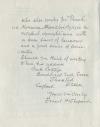 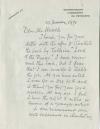 |
SHEPARD ERNEST H.: (1879-1976) English Artist & Book Illustrator. A.L.S., Ernest H. Shepard, two pages, 8vo, Lodsworth, nr. Petworth, 19th January 1970, to Mr. [Rogerio] Haack. Shepard thanks his correspondent for their letter and invitation to illustrate Tolkien’s The Lord of the Rings, although remarks ‘I have never read this book, but I fear I am unable to tackle the job…I was 90 on Dec 10th….At my age I feel I have the right to retire in favour of a younger artist’. Shepard continues ‘I can recommend one with experience in illustrating who also works for “Punch”, i.e. Norman Mansbridge, is an excellent draughtsman with a keen sense of humour and a good sense of caricature’ and concludes by providing Mansbridge’s address in Essex. A letter of interesting content. About EX £150 - 200
Norman Mansbridge (1911-1993) English Illustrator & Writer, political cartoonist for Punch.
|
|

|
SEARLE RONALD: (1920-2011) British Artist & Cartoonist. An excellent original black pen and ink drawing signed by Searle, one page, 4to, n.p., n.d. (c.1940?). Searle has drawn a profile head and shoulders study of a military officer. Signed (‘Ronald Searle’) at the base of the drawing. About EX £300 - 400
Searle made many drawings, possibly including this one, while a Prisoner-of-War of the Japanese during World War II. The majority of the 300 drawings he made are in the permanent collection of the Imperial War Museum and most also appeared in his book Ronald Searle: To the Kwai and Back, War Drawings 1939-1945 (1986).
The paper bears the watermark of Jarrolds, the Norwich department store.
|
|

|
BLAKE QUENTIN: (1932- ) English Illustrator and Children’s writer. A good original blue pen and ink drawing signed by Blake, one page, 4to, n.p., 1994. At the centre of the page Blake has drawn a full length image of a bird holding a white card in its beak, the greeting Best Wishes appearing in Blake’s hand on the card. Signed and dated by Blake immediately beneath the drawing. Some very light central vertical and horizontal folds and some extremely minor surface creasing, VG £200 - 300
|
|

|
LANTZ WALTER: (1899-1994) American Animator, creator of Woody Woodpecker. Two printed 4to (and small 4to) pieces of printed ephemera, individually signed by Lantz, the first being a colour front cover to a Woody Woodpecker magazine and the second being a magazine advert for Marshmallow Treats using Kellogg’s rice krispies, featuring an image of Woody Woodpecker. Both are signed in bold black inks by Waltz with his name alone to clear areas. Together with a selection of unsigned photographs and negatives of various sizes, each depicting Lantz in different poses, and a few pieces of printed ephemera etc. Some light creasing and small tears to the edges of the two signed items (one with small areas of paper loss at the base). G to VG, 17 £80 - 100
|
|

|
ART & LITERATURE: Small selection of signed postcard photographs and slightly smaller (1) by various writers, playwrights and artists comprising John Osborne, Henry Moore, Harold Pinter, Alan Ayckbourn, Pietro Annigoni, Robert Layton and H. Montgomery Hyde. VG to EX, 7 £100 - 150
|
|

|
DENHAM JOHN: (1615-1688) Anglo-Irish Poet & Courtier, Surveyor of the King’s Works 1660-69. Concluding portion of an A.L.S., Jo: Denham, one page (the lower half of a 4to page), n.p., n.d., to an unidentified gentleman. The concluding five complete lines of holograph text state ‘….not being willing to go any unusuall ways, and I hope wee shall not fare the worse for doinge so, especially relying upon your Care of us, whom wee have allways found so just and kind to us, as I assure you, you shall find me in any thing wherin I cann make you a returne…’ and with a holograph subscription. Rare. Neatly laid down, otherwise VG £200 - 300
|
|
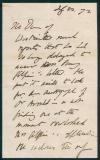 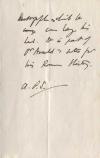 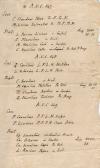 |
ARNOLD THOMAS: (1795-1842) English Educator & Historian, headmaster of Rugby School from 1828-41. Autograph Manuscript, unsigned, one page, 8vo, n.p., n.d. (c.late 1830s). The page comprises various holograph notes, in Latin, in three sections headed A.U.C. 547, A.U.C. 548 and A.U.C. 549, and are research notes made by Arnold in preparation for his History of Rome. Accompanied by Arthur Stanley (1815-1881) English Churchman, Dean of Westminster. A.L.S., The Dean of Westminster, in the third person (although also signed with his initials A.P.S. at the conclusion), two pages, 8vo, n.p. (London?), 22nd July 1872, to Mrs. Griffin, apologising for the long delay in replying to his correspondent’s letter and explaining ‘He put it aside to look for an autograph of Dr. Arnold - & not finding one at the moment overlooked Mrs. Griffin’s application’ and continuing ‘He encloses the only autograph which he can lay his hand. It is part of Dr. Arnold’s notes for his Roman History’. Some light age wear, a few small tears to the edge of Arnold’s manuscript and slight traces of former mounting to the verso, otherwise VG, 2 £150 - 200
Arnold’s unfinished History of Rome was published in three volumes 1838-42.
|
|
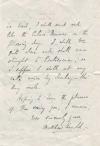 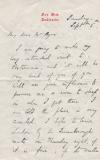 |
ARNOLD MATTHEW: (1822-1888) English Poet & Cultural Critic, the son of Thomas Arnold. A.L.S., Matthew Arnold, two pages, 8vo, Ambleside, 5th September n.y., to Mr. Ayre. Arnold informs his correspondent that he is going to make his long intended visit to Pontresina in Switzerland and asks him to use his influence to procure a room in which Arnold can sleep when he gets there, remarking ‘I am told the place is very crowded’. The poet further writes of his travel arrangements, ‘I hope to leave London by the Queensborough route on Thursday night, if it is fine; if the weather is bad, I shall wait and take the Calais Douvres on the following day’ and also adds ‘I shall be quite alone and shall come straight to Pontresina, so I suppose I shall at any rate arrive by Sunday – this day week’. With blank integral leaf. VG £100 - 150
|
|

|
NEILL A. S.: (1883-1973) Scottish Educator and Author, the founder of Summerhill School. A.L.S., A. S. Neill, one page, 4to, Long Acre, London, 4th September 1913, to Mr. Angus, on the printed stationery of the publishers T. C. & E. C. Jack. Neill thanks his correspondent for the delightful evening he and Harding had spent with them all and continues ‘Tell Mary I forgot to take away my bottle of ink. I may come up for it tomorrow night if I have time. If I don’t……ah well Mary may use it or sell it by auction’. Some minor, light foxing, otherwise VG £100 - 120
|
|

|
DICKENS CHARLES: (1812-1870) English Novelist. Early Autograph Envelope Signed, simply addressed by Dickens to Miss Ely and signed (‘Charles Dickens’) to the lower left corner. With a good black wax seal to the verso. Some light overall creasing and age wear, very slightly affecting the signature, and with a small pinhole and stain to the upper edge, G £200 - 300
The recipient of the present envelope (and the letter which it originally contained) would have been Miss. Marion Ely, the niece of Rachel Talfourd, wife of Thomas Talfourd (1795-1854) English Judge, Politician and Author. Dickens dedicated The Pickwick Papers to Talfourd.
Ely lived with the Talfourds at their home in Russell Square. The Charles Dickens Letters Project records ten letters from Dickens to Ely dated between 1837 and 1862.
|
|

|
DICKENS CHARLES: (1812-1870) English Novelist. Autograph Envelope Signed, addressed by Dickens in his familiar blue ink to Dr. Southwood Smith at 38 Finsbury Square. The original postage stamp has been neatly removed (leaving a portion of adhesive residue) although the envelope is post marked 28th May 1844 to the verso. Signed (‘Charles Dickens’) to the lower left corner. With the remnants of a red wax seal to the verso. Neatly inlaid and with some slight age wear, G £200 - 300
Dr. Thomas Southwood Smith (1788-1861) English Physician & Sanitary Reformer.
In 1837, Thomas Southwood Smith issued his Report on the Physical Causes of Sickness and Mortaliy to which the poor are regularly exposed and which are preventable by Sanitary Measures. As a result Southwood Smith escorted Dickens to see the poor conditions described in the report, which prompted the novelist to write Bleak House and Oliver Twist
|
|

|
DICKENS CHARLES: (1812-1870) English Novelist. A.L.S., Charles Dickens (a good, bold example with paraph), one page, 8vo, Devonshire Terrace, York Gate, Regents Park, 16th May 1843, to N[assau]. W[illiam]. Senior, marked ‘Private’. Dickens writes, in full, ‘Circumstances have come to my knowledge, which induce me to think, in common with some other friends of Mr. Black, that it will be better to postpone for the present, that proposed friendly and private dinner to him, (involving no other question of any kind) in reference to which I troubled you with a note a few days since’. With blank integral leaf (some slight traces of former mounting to the verso). An attractive and boldly penned letter. VG £800 - 1200
Nassau William Senior (1790-1864) English Lawyer & Economist.
John Black (1783-1855) British Journalist and Newspaper Editor of the Morning Chronicle from 1817-43. Black employed the young Dickens who later referred to the Editor as ‘my first hearty out-and-out appreciator’.
|
|

|
COLLINS WILKIE: (1824-1889) English Novelist. Bold, dark ink signature (‘Wilkie Collins’) and three additional words in his hand, on a small oblong 12mo piece clipped from the conclusion of a letter. With several additional words in his hand to the verso. VG £100 - 120
|
|

|
COLLINS WILKIE: (1824-1889) English Novelist. Bold, dark fountain pen ink signature (‘very truly yours Wilkie Collins’) and date, 20th April 1876, in his hand on an oblong 12mo piece evidently removed from the conclusion of a letter. VG £100 - 120
|
|

|
COLLINS WILKIE: (1824-1889) English Novelist. Concluding page of an A.L.S., Wilkie Collins, one page, 8vo, n.p., n.d., to an unidentified correspondent. Collins writes, in part, ‘…But, even in the face of illness, I am on obstinate man - and I don’t yet give up the hope of improving our acquaintances which I remember with sincere pleasure’. With heavy traces of former mounting to the verso, about VG £200 - 300
|
|

|
JAMES HENRY: (1843-1916) American-born British Author. A.L.S., Henry James, one page, 4to, Cheyne Walk, 19th March 1914, to ‘My dear Edward!’. James sends his correspondent a reminder about his attendance at luncheon the following day, remarking ‘Please measure my lively desire to welcome you by the risk I then take of appearing importunate & imparting to you a possible lapse of memory. You see I don’t mind your decision if I provide against any chance!’ One very slight, neat split to the left edge of the central fold, not affecting the text or signature, otherwise VG £200 - 300
|
|

|
WILDE OSCAR: (1854-1900) Irish Playwright & Novelist. Ink signature (‘truly yrs Oscar Wilde’) on a slim oblong 12mo piece evidently neatly clipped from the conclusion of a letter, with eight additional words in his hand to the verso, referring to his correspondent being near Chelsea the following day. A very light, minor smudge at the conclusion of the signature. VG £400 - 600
|
|

|
WILDE OSCAR: (1854-1900) Irish Playwright & Novelist. A good A.L.S., Oscar Wilde, one page, 8vo, Salisbury Street, London, n.d. (c.1880), to Bram Stoker (‘Dear Stoker’). Wilde writes, in full, ‘I am anxious to accompany some friends to the Lyceum tonight. If you could place a seat anywhere at my disposal I would be very much obliged’. A boldly penned letter with a fine and interesting association. Some very light age wear and a small tear to the left edge, not affecting the text or signature, otherwise about VG £4000 - 6000
Bram Stoker (1847-1912) Irish Author of Dracula. Personal Assistant to actor Henry Irving and Business Manager of the Lyceum Theatre, which Irving owned.
The relationship between Stoker and Wilde is an interesting one; the two had first met at Trinity College, Dublin, when Stoker, President of the university’s Philosophical Society, proposed Wilde for membership. Their friendship grew from strength to strength and Stoker was invited to literary parties hosted by Wilde’s mother. However, after leaving Trinity, the two men both fell in love with the same woman, Florence Balcombe (1858-1937), a celebrated beauty. Wilde apparently became engaged to Balcombe, however she was to choose Stoker as her husband, the couple marrying in 1878 and moving to London in order that Stoker could take up his position as manager of the Lyceum Theatre. Wilde was heartbroken and upset at Balcombe’s decision, however within a few years (as the present letter illustrates) the two men had renewed their acquaintanceship.
Wilde came to live in London in 1879, taking quarters off The Strand at 13 Salisbury Street, from where the present letter was written. He shared the residence with the artist Frank Miles, whom he had known at Oxford. The actress Lillie Langtry described the house, characterised by serpentine hallways, shadowy corners and awkwardly shaped rooms, as ‘untidy and romantic’.
|
|

|
HAGGARD H. RIDER: (1856-1925) English Writer of Adventure Novels. A.L.S., H Rider Haggard, one page, 8vo, Ditchingham House, Bungay, 6th November 1891, to his brother Andrew, on black bordered mourning stationery also featuring a printed Egyptian cartouche. Haggard states that he hopes his brother is well again and getting on all right, and also remarks ‘I fear that this Brazilian smash will be bad news for Will’. An A.N.S., Andrew C P Haggard, by Andrew Haggard appears at the foot of the letter and reads, in full, ‘Dr. Bedingfield, Here you are, a complete letter of my brother’s to me’. Some very light, extremely minor age wear and slight traces of former mounting to the verso, VG £80 - 100
Andrew C P Haggard (1854-1923) British Lieutenant-Colonel, elder brother of H. Rider Haggard.
In the present letter Haggard refers to another elder brother, William Henry Doveton Haggard (1846-1926) British Diplomat who served as the United Kingdom’s Envoy Extraordinary and Minister Plenipotentiary to the United States of Brazil from 1906-15.
Brazil’s second Constitution was written in 1891, in the same year as the present letter, and followed the Proclamation of the Republic in Brazil on 15th November 1889.
|
|

|
DOYLE ARTHUR CONAN: (1859-1930) Scottish Author, creator of Sherlock Holmes. A.L.S., A Conan Doyle, one page, 8vo, Undershaw, Hindhead, Haslemere, n.d., to Mrs. Whitaker. Doyle writes, in full, ‘I fear the rain & wind will make tennis impossible and I have some work which should be done - but many thanks none the less for your most kind invitation’. Together with a bold ink signature (‘ACD’, with his initials) and three additional words in his hand on a small oblong 12mo piece very slightly irregularly clipped from the conclusion of a letter or note. VG, 2 £200 - 300
|
|

|
BUCHAN JOHN: (1875-1940) Scottish Novelist of The Thirty-Nine Steps, later Governor General of Canada 1935-40. T.L.S., John Buchan, one page, 4to, Elsfield Manor, Oxford, 5th July 1932, to Camden Morrisby in Sydney, Australia. Buchan writes, in full, ‘I gladly send you my own book plate (no longer present) which is a view from my house near Oxford, in return for your most interesting plate. Lindsay’s work is very remarkable’. Together with an ink signature (‘John Buchan’) on a small 12mo piece clipped from the conclusion of a letter with several additional typed words of text, neatly laid down. G to VG, 2 £80 - 100
Lionel Lindsay (1874-1961) Australian Artist, Etcher & Engraver.
|
|

|
FLEMING IAN: (1908-1964) British Author, creator of James Bond. T.L.S., with his initials I F, one page, 4to, n.p. (London), 9th July 1951, to Michael Parker at the Land Commissioner’s Office in Hamburg. The carbon typed letter is an original copy of a letter from Fleming, thanking Parker for their letter although remarking ‘but are we not getting rather at cross purposes?’ and continuing ‘we are already handsomely represented throughout the British Zone and have no further accreditation available for that territory. As I understood from….our later correspondence, you had suggested representing us in Munich and the United States Zone where we could do with some additional coverage in case of emergencies. In the circumstances I think the best course would be for you to ascertain first of all if there is any hope of obtaining authority to work in the United States Zone, bearing in mind that British accreditation is, in fact, of no interest to the American authorities….’ Fleming concludes by suggesting ‘Perhaps on your next visit to Berlin you would like to have a talk with Anthony Terry, our chief representative in Germany. He will at any rate be able to explain to you our coverage in the British Zone and perhaps give you some hints on how to penetrate into the American sector.’ The letter is marked at the head ‘Copy to Mr. Terry’. Two file holes to the left edge, small staple holes to the upper left corner and with some light creasing to the edges, none of which affect the text or signature, about VG £400 - 500
Antony Terry (1913-1992) British Journalist, a former European Editor of The Sunday Times who was first hired in 1949 by Fleming (at the time the Foreign manager for the newspaper). Terry’s obituary in The Independent stated that he was ‘one of the paper’s most valuable assets, a one-man listening post, a fastidious checker of facts, a burrower into dark corners and a traveller who never complained of fatigue’.
|
|

|
STRACHEY LYTTON: (1880-1932) British Writer & Critic, a founding member of the Bloomsbury Group. A.L.S., Lytton Strachey, one page, 8vo, Brighton, 31st December 1927, to Hubert, on the printed stationery of the Royal Albion Hotel. Strachey informs his correspondent that he has just received their letter and continues ‘The Curtis Brown offer seems to me well worth accepting, and I think your proposal that we should divide the proceeds - each getting 10 guineas an article - is quite fair’. He concludes by returning some corrected proofs (no longer present). One very slight, minor paperclip rust stain to the upper left corner, not affecting the text or signature, VG £100 - 150
Curtis Brown - One of the oldest literary agencies in Europe, based in London, founded by Albert Curtis Brown in 1899.
|
|

|
GARNETT DAVID: (1892-1981) British Writer of the novel Aspects of Love (1955). Garnett, who controversially married Virginia Woolf’s niece, was a prominent member of the Bloomsbury Group. A.L.S., David Garnett, one page, 8vo, Hilton Hall, Hilton, Huntingdon, 22nd September 1949, to Mr. [John] Howarth. Garnett informs his correspondent that he doesn’t want to sell any of D. H. Lawrence’s letters although adds ‘However, he must have written thousands: Huxley’s volume of the letters is only a selection & I don’t think you’ll find a great difficulty in getting one.’ In concluding he remarks ‘I share your respect for D.H.L. as a writer’. VG £100 - 120
|
|
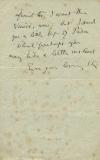 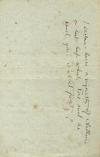 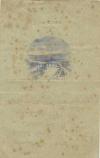 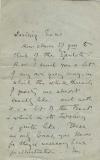 |
RUSKIN JOHN: (1819-1900) English Critic & Author. An unusual A.L.S., with his initials J R, three pages, 8vo, n.p. (Pisa), n.d., to ‘Darling Susie’ (Beever). Ruskin announces ‘How clever of you to think of the Epidote’ and continues ‘But I send you a bit of my own grey crag, in which the white threads of quartz are almost exactly like…’, also informing her that ‘These are only loans, you know, for they’re necessary here for illustration’. Ruskin concludes by referring to Venice and remarks, ‘but I send you a little bit of Pisa which perhaps you may like….’ And in a postscript adds ‘…here’s a vignette of Arthur’s on last leaf….isn’t it pretty?’. To the final page appears a charming watercolour vignette by Arthur Severn (unsigned), the image, presumably of Pisa, showing the River Arno with a bridge running across it and the city either side. Some light overall foxing and minor creasing, G £100 - 150
Susan ‘Susie’ Beever (1805-1893) Resident of Coniston and one of Ruskin’s most important friends during the 1870s and 1880s.
Arthur Severn (1842-1931) British Artist, son of Joseph Severn (1793-1879) English Portrait Painter and friend of John Keats. In 1871 Arthur Severn married Joan Ruskin Agnew, a cousin of John Ruskin.
|
|

|
DAVIDSON JOHN: (1857-1909) Scottish Poet, known for his ballads. Autograph Poem Signed, John Davidson, one page, folio, n.p., n.d. (c.1896/7). The manuscript poem is entitled Sunset and is a sestet of four stanzas of six lines each, beginning ‘By down and shore the Southwest bore/ The scent of hay, an airy load:/ As if at fault it seemed to halt/ Then, softly whispering, took the road/ To haunt the evening like a ghost/ Or some belated pilgrim lost’ and concluding ‘Where shadow fell in glade and dell/ Uncovered shoulders nestled deep/ And here and there the braided hair/ Of rosy goddesses asleep:/ For in a moment clouds may be/ Dead, and instinct with deity’. Signed by Davidson at the foot. Autograph manuscripts of Davidson are scarce, not least due to his suicide at the age of 50. The page has at one stage been torn horizontally at the centre (not affecting the text) and is repaired to the verso. Some light creasing, age wear and a few minor tears at the edges, not affecting the text or signature, about G £150 - 200
The present manuscript poem differs very slightly to the version in New Ballads (published by John Lane, The Bodley Head, London, 1897), a photocopy of which is included in the lot.
|
|

|
WORDSWORTH WILLIAM: (1770-1850) English Poet Laureate 1843-50. Bold ink signature (‘Wm. Wordsworth’) and date, London, 1st September 1837, in his hand on a slim oblong 8vo piece. Neatly laid down and with some minor age wear, otherwise VG £100 - 120
|
|

|
BROWNING ROBERT: (1812-1889) English Poet. Bold, dark fountain pen ink signature (‘Robert Browning’) on a small slim oblong 12mo piece, matted in green beneath an original sepia carte-de-visite photograph of the poet seated in a half length pose and alongside a printed poem entitled Home-Thoughts, from Abroad. Framed and glazed to an overall size of 11 x 9.5. VG £100 - 120
|
|

|
BROWNING ROBERT: (1812-1889) English Poet. Signed Free Front envelope panel, addressed in Browning’s hand to The Rev. Dr. Scott at Balliol College, Oxford. Bearing a Penny Red postage stamp and post marked at London, 3rd April 1867. Signed (‘Robert Browning’) to the lower left corner. About VG £200 - 300
Robert Scott (1811-1887) British Academic Philologist & Church of England Priest, Master of Balliol College, Oxford 1845-70.
|
|

|
BLUNDEN EDMUND: (1896-1974) English Poet. A.L.S., E Blunden, on one side of a plain postcard, Talbot Road, London, n.d. (18th October 1929), to [The Editor?] of The Nation. Blunden informs his correspondent ‘There is a poetry book about to appear which I shd say deserves to be considered in my next compendious verse review, if you haven’t already disposed of it otherwise’ and adds ‘It is called Caesar Remembers, by W. Kean Simpson’. Some slight traces of former mounting to the verso, affecting Blunden’s holograph address and totally obscuring the name of his correspondent and much of the address. Otherwise VG £100 - 120
|
|

|
BETJEMAN JOHN: (1906-1984) British Poet Laureate 1972-84. A.L.S., John Betjeman, one page, 8vo, Edgecliff, Sydney, New South Wales, 11th September 1961, to Dr. Frazer, on the printed stationery of The British Council. Betjeman states that it was kind of his correspondent to send him his book of poems and that he looks forward ‘to reading them in what moments of peace & calm I can snatch on a whirlwind tour of this wonderful continent’. About EX £80 - 120
|
|

|
GRAVES ROBERT: (1895-1985) English Poet. A.L.S., The Seizin Press, one page, small 8vo, n.p. (Mallorca, Spain), 7th December 1973, to Colin Huggett. Graves announces ‘It may not have occurred to you that autographed editions of poems are sold usually at double the price of unautographed copies – for the poet’s benefit and also for the publisher’s – who stands to make little profit from unautographed copies whether by well-known or ill-known or unknown poets’ and concludes ‘As a printer and publisher I have never made enough money from poems to pay my expenses. Have you?’. Accompanied by the original envelope hand addressed by Graves. The nature of Huggett’s enquiry to Graves is not known, but given the rather prickly response by Graves relating to signed editions it is perhaps no surprise that the poet chose to sign the present letter in the name of his press rather than with his own name. VG £100 - 150
The Seizin Press was a small press founded by Robert Graves and Laura Riding in London in 1927. It operated out of Mallorca from 1930-37 publishing works by Graves and Riding as well as Gertrude Stein and others. It ceased publication on the outbreak of the Spanish Civil War, but was later revived as The New Seizin Press.
|
|

|
LITERATURE: Selection of A.Ls.S. and a few T.Ls.S. by various poets and writers etc., including Laurence Binyon, Robert Bridges, Arthur Quiller-Couch (a letter of good content, praising his correspondent’s poetry and stating, in part, ‘My pleasure, too, had a handicap you couldn’t be aware of: for I have to confess that while I am a purist about sonnets in the matter of their form. I don’t seem to enjoy the sonnet as other folks do. Only the best appeal to me, and there is no form of poetry that so easily bores me’, 8th January 1907), Arthur Symons, Charles Angell Bradford, Ray Coryton Hutchinson, Norman Douglas etc. A number of the letters are written to Sir Courtenay Mansel. G to generally VG, 10 £100 - 120
Sir Courtenay Mansel (1880-1933) Welsh Landowner and Farmer, Barrister and Liberal Party Politician who later joined the Conservatives.
|
|
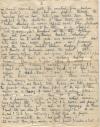 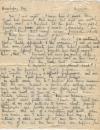 |
DU MAURIER DAPHNE: (1907-1989) British Author. Incomplete A.L., unsigned, being the first two pages of a longer letter, 4to, Cornwall, n.d. (‘Housekeeping Day’, 1930s), to [Foy Quiller-Couch]. Du Maurier exclaims ‘Yes – I was right. I knew how it would be if you had possessed Black Magic last night you would have seen Mrs. Burghand at the piano, eyes fixed feverishly on piece of music, demanding in frantic tones that some unseen presence should “Bring her, her chariot of fire, Bring her her arrows of desire“ (a sentiment, I feel, hardly appropriate to the occasion!)’ and further amusingly recounts the evening’s events, ‘My spirits sank as Mrs. Masters from Truro announced that all over England a quarter of a million women were meeting together as we were doing, and that she hoped we would all turn up at the annual Womens Institute gathering at the Albert Hall in February. My spirits sank further when I heard the Out and Out at my side muttering to someone about private theatricals, and finally reached zero when Mrs. Burghand told us of a competition next month when every member was to make a ladies hand bag, the materials of which must not cost more than a shilling! A cup of tea and two buns found me happier…..And, had you peeped through the window half an hour later, you would have been gratified by the spectacle of these twenty five little ladies standing in rows opposite each other, hysterically passing tennis balls one to the other in a strange form of race, Mrs. Burghand at the top doling them out from a mysterious basket, shouting directions as to which side was winning – and later still you would have seen me prancing round….in a riotous display of musical chairs – a game which by some appalling fate I always succeed in winning!!’ Some light overall creasing and a few minor tears at the edges, G £150 - 200
Foy Quiller-Couch - daughter of British writer Arthur Quiller-Couch (1863-1944), and a life-long friend of Du Maurier. Indeed, Du Maurier was accompanied by Foy Quiller-Couch when she became inspired with the storyline for her novel Jamaica Inn. In 1930 the two ladies were staying at Jamaica Inn and went riding on Bodmin Moor. They became lost in bad weather conditions and apparently sheltered for some time in a derelict cottage on the moor but were eventually led back to Jamaica Inn by their horses.
|
|
 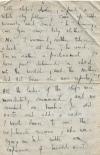 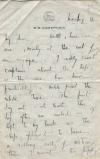 |
DU MAURIER DAPHNE: (1907-1989) British Author. Incomplete A.L., unsigned, being the first four pages of a longer letter, 8vo, n.p. (at sea, en route to Egypt), n.d. (‘Monday 16’, 1936), to [Foy Quiller-Couch], on the printed stationery of S. S. Cameronia. Du Maurier states that she is reaching the end of her voyage, but has no complaints as the sea has been calm the whole time, informing her friend, ‘The first day out – at least the day after we sailed – I kept to my bunk as the ship appeared to have a rolling sort of motion that I wasn’t too happy about. Also we were in the Bay of Biscay, also the day was cold and grey, and bearing Miss. Robert’s maxim in mind I decided “There was nothing to get up for“’ and further referring to her young daughter and husband (‘a little pale about the gills’) and the rest of the trip, ‘Off Spain the weather grew lovely, and ever since we have had blue skies and brilliant sunshine. We passed Gibraltar, and wished we had been going there instead of Egypt. It was rather like St. Austell Bay.’, and providing an anecdote, ‘Only excitement so far was yesterday afternoon when the little ships’ doctor, a pink & white shy fellow, came up rather nervously and said “Mrs. Browning, can you sew baby clothes“? “No“, I answered, rather taken a back. “Oh dear“, he said, “I’m in rather a predicament. I have just delivered a child into the world, and the mother did not know she was expecting“!! All the ladies of the ship were immediately summoned, and we searched our trunks for old vests and odds & ends. I went down to see the unfortunate woman, who was lying in bed with an expression of bewilderment’. Some light creasing, otherwise about VG £150 - 200
Foy Quiller-Couch - daughter of British writer Arthur Quiller-Couch (1863-1944), and a life-long friend of Du Maurier. Indeed, Du Maurier was accompanied by Foy Quiller-Couch when she became inspired with the storyline for her novel Jamaica Inn. In 1930 the two ladies were staying at Jamaica Inn and went riding on Bodmin Moor. They became lost in bad weather conditions and apparently sheltered for some time in a derelict cottage on the moor but were eventually led back to Jamaica Inn by their horses.
Du Maurier accompanied her husband, Lieutenant General Frederick Browning (1896-1965), to Egypt when the 2nd Battalion, Grenadier Guards, of which he was the Commanding Officer, were deployed to Egypt in 1936.
|
|
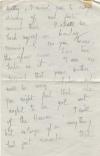 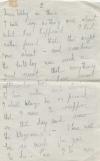 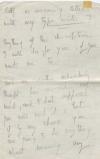 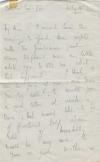 |
DU MAURIER DAPHNE: (1907-1989) British Author. Incomplete A.L., unsigned, being the first four pages of a longer letter, 8vo, n.p. (‘Sister-in-law’s flat’), n.d. (‘Friday 12th’, May 1944), to ‘My dear’ (Foy Quiller-Couch). Du Maurier, writing in pencil, states that she is spending three nights with the Guardsman (her husband, Lieutenant General Frederick Browning) and that Nanny had telephoned her ‘a little while ago to tell me what had happened’, continuing ‘I think I am too fond of you, and know you too well, to write you a real letter at such a time, but would like to be of practical help above all. If Menabilly would be any use to you or your mother or Betty, I want you to….just arrive there….I am so worried that your mother will be very shaken, and you might feel that she ought to be got out of the Haven. I will not enlarge upon anything but just remember that Menabilly is there. I will say nothing more about what has happened. I had rather feared that this might come about – and somehow the birthday was such a great event that everything afterwards must have seemed to him rather anti-climax. I shall always be so proud that I came to supper on that day and saw the telegrams. There will be so much for you to do. Can I be any help in answering letters with my type-writer? Anything of this description I will do for you, if you want me to’. Some light age wear and a small sellotape stain to the head of each page, only very slightly affecting a few words of text, otherwise about VG £150 - 200
Foy Quiller-Couch - daughter of British writer Arthur Quiller-Couch (1863-1944), and a life-long friend of Du Maurier. Indeed, Du Maurier was accompanied by Foy Quiller-Couch when she became inspired with the storyline for her novel Jamaica Inn. In 1930 the two ladies were staying at Jamaica Inn and went riding on Bodmin Moor. They became lost in bad weather conditions and apparently sheltered for some time in a derelict cottage on the moor but were eventually led back to Jamaica Inn by their horses.
The present letter was evidently written on the occasion of the death of Sir Arthur Quiller-Couch on 12th May 1944. He had celebrated his 80th birthday in November 1943 and died after being hit by a jeep near his home in Cornwall.
|
|
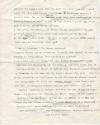 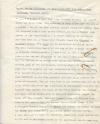 |
DU MAURIER DAPHNE: (1907-1989) British Author. Typed Manuscript, unsigned, two pages, 4to, n.p., n.d. The manuscript, which features a few small holograph corrections by Du Maurier, is entitled Doctor Carfax discusses the Long Stone with the Notary from Brittany, Monsieur Ledru and was evidently used by Du Maurier in preparation Castle Dor. The manuscript states, in part, ‘Why, man, I pass that long Stone (as we call it) almost every day of my life : have examined it many times with the aid of a ladder – for it has been planted upright since its removal from its original site, a rood or two distant, and was a funeral slab carved to lie horizontally – in which position it was found. You have seen it. I helped your fingers trace the Cunomori or Cunowori filius. The jacet can be deciphered by aid of faith. The full inscription begins at the top of the up-ended stone and is actually undecipherable. I have tried it with a magnifying glass, under various altitudes of the sun. I have taken rubbings. But the granite is so eroded that nobody can faithfully report of that part of the inscription. Knowing what I do of granite I avow that the erosion has been considerable even in my lifetime……’ Two paperclip rust stains to the right edge of the first page, only very slightly affecting a few words of text, and with some light creasing. Together with an A.L.S., Syb, by an unidentified friend of Du Maurier, four pages, 4to, Garrick Avenue, London, 14th March 1940, to Du Maurier (‘Dearest Daph’). The lady writes a largely social letter to Du Maurier, referring to a payment for a statuette and the illness of a mutual acquaintance, ‘You know, Daph, it sounds to me like delayed concussion, which is bad….Angela says if I go down, it might frighten her, which is such rot – people must know when they are ill, I never do believe in hiding facts….I know Mo is a bad patient, very irritable, bless her heart, but to say it may make trouble with the servants if I go is silly….The Dr. says she must be kept cheerful – that’s a tall order these days of this foul war. The papers don’t help one to be very cheerful, do they?’ Some light age wear, G to about VG, 2 £200 - 300
Castle Dor is a historical novel by Daphne Du Maurier, published in 1961 after she had completed the unfinished manuscript of Sir Arthur Quiller-Couch’s last novel. Quiller-Couch’s daughter, Foy, had given her blessing for Du Maurier to complete the work.
|
|
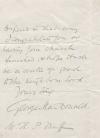 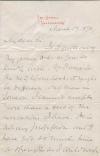 |
MACDONALD GEORGE: (1824-1905) Scottish Author, Poet and Christian Minister. A pioneer of fantasy literature, MacDonald served as a mentor to fellow writer Lewis Carroll. A.L.S., George MacDonald, two pages, 8vo, Hammersmith, 17th March 1870, to Thomas P. Muff. MacDonald announces ‘It is quite out of my power to do as you kindly wish’, explaining that he cannot accept more than a few of the invitations he receives and adding ‘It is not my profession and I have not so much time or strength as I could wish to spend in that way’. The author concludes ‘I congratulate you on having your church finished, & I hope it will be a centre of good to the neighbourhood’. With blank integral leaf (slight traces of former mounting to the verso). VG £80 - 120
‘I don’t want to be drawn orpainted by any one’
|
|

|
BARRIE J. M.: (1860-1937) Scottish Novelist, created Peter Pan. An interesting A.L.S., J. M. Barrie, one page, 8vo, Strand, London, 24th September 1922, to [Edmond] Kapp. Barrie apologises for the delay in replying to his correspondent’s letter, explaining ‘it is not because I don’t see that your work is quite remarkable, nor because your letter gives me no pleasure (avoid too many negatives). Much the reverse’ and adding ‘I don’t want to be drawn or painted by any one (Meredith once said to me that only great men and beautiful women should be thus honoured, and that he was neither one nor other) but I should like to meet you’, concluding by suggesting a meeting next Sunday afternoon. A letter of good content and association. VG £150 - 200
Edmond Kapp (1890-1978) British Portrait Painter.
|
|

|
MILNE A. A.: (1882-1956) English Author, creator of Winnie-the-Pooh. Brief A.L.S., A. A. Milne, one page, 8vo, Chelsea, n.d., to Wright (‘(or somebody)’). Milne states, in full, ‘This is just to say that the cricket article will reach you on Tuesday’. Some very slight wrinkling and extremely light staining to the four corners, evidently caused by previous mounting, not affecting the text or signature. About VG £150 - 200
|
|
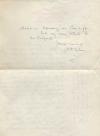 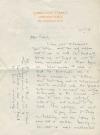 |
MILNE A. A.: (1882-1956) English Author, creator of Winnie-the-Pooh. A.L.S., A. A. Milne, two pages, 8vo, Mallord Street, Chelsea, 22nd February 1937, to David Ecles. Milne states that he has only just re-discovered his correspondent’s letter and apologises for having been ‘so rude (or, preferably, let us say so busy) as not to have answered it’, further adding ‘What makes it worse is that the photograph was a terrific success in the kitchen, and that any sort of enlargement would be received with the greatest enthusiasm – as would an outdoor photograph in the summer. So I seem to have been not only rude to you but unkind to the cook. More apologies all round’. Milne also comments on the weather, ‘Brackley in the wet is most unattractive. Almost as depressing as Cambridge’ and in a postscript remarks ‘If you are so kind as to send an enlargement, send it to Mrs. Gulliver – who would thank you for it immediately!’. Accompanied by the original envelope hand addressed by Milne. VG £200 - 300
|
|

|
CHILDREN’S LITERATURE: Selection of signed cards, signed colour postcard reproductions, a few letters and signed photographs etc., by various writers and illustrators associated with Children’s Literature including Ivor Wood (2; one featuring an original pen and ink sketch of Postman Pat), David McKee, Peter Firmin, Elisabeth Beresford, Kathleen Hale, Rev. W. Awdry, Anthony Buckeridge, John Harrold etc. Some duplication. Generally VG to EX, 19 £100 - 120
|
|

|
TAGORE RABINDRANATH: (1861-1941) Indian Poet, Nobel Prize winner for Literature, 1913. Fountain pen ink signature (‘Rabindaranth Tagore’) to the clear centre of an attractive postcard bearing an attractive printed design of a purple seal and ribbons. Dated 1916 in another hand. Some light age wear, otherwise VG £100 - 120
|
|
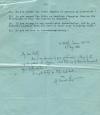 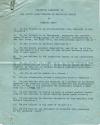 |
SHAW GEORGE BERNARD: (1856-1950) Irish Playwright, Nobel Prize winner for Literature, 1925. A.L.S., G. Bernard Shaw, to the lower half of the second page of an original typed manuscript prepared by Shaw, two pages, 4to, Adelphi Terrace, 2nd August 1926, to Leonard Woolf (‘My dear Woolf’). Shaw writes, in full, ‘Here is my expansion of your questionnaire. Many of the original questions were ambiguous. I don’t think any of these can be answered by a double entendre. I am just starting for Italy, dead beat’. The typescript is entitled Suggested Amendment of The Nation Questionnaire on Religious Belief by Bernard Shaw and comprises seventeen numbered questions including ‘1. Do you believe in an anthropomorphic God, external to his creatures?....3. Do you believe in personal immortality? 4. Do you desire personal immortality; and if so, is it for your own sake or for the sake of some beloved deceased whom you wish to meet again?....7. Are you an active member of a Church?....9. Do you believe that the Universe is a product of accidental physical and chemical action, cold, indifferent and meaningless? If so, to what do you attribute the difference between a dead body and a living one? 10. Do you believe in heaven or hell as actual spatial localities in the Universe in which immortal souls spend eternity?.....12. Do you believe in any form of evolution?.....14. Do you accept the first chapter of Genesis as historical?.....’ An interesting letter and manuscript. A slight paperclip rust stain appears to the upper left corner of each page, not affecting the text or signature, and with some slight creasing, otherwise about VG £200 - 300
Leonard Woolf (1880-1969) English Political Theorist & Author, husband of Virginia Woolf.
The Nation was a political weekly newspaper formed in 1921. Woolf served as literary editor from 1923-30.
|
|

|
BUCK PEARL S.: (1892-1973) American Writer and Novelist who spent much of her early life in China where she wrote The Good Earth (1931). Nobel Prize winner for Literature, 1938. Vintage signed 5 x 7 photograph of Buck in a profile head and shoulders pose, gently resting the side of her face on one raised hand in a pensive manner. Signed in blue fountain pen ink with her name alone to the lower white border. Some slight corner and surface creasing. Together with a printed 4to brochure entitled A Biographical Sketch of Pearl S. Buck, published by The John Day Company, New York, n.d. (c.1968), signed by Buck in bold blue fountain pen ink with her name alone to a clear area of the front cover, which also features the novelist’s image. Horizontal central fold, not affecting the signature. G, 2 £100 - 150
|
|
 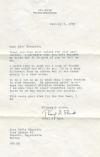 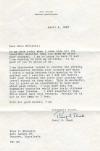 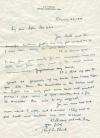 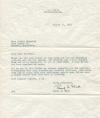 |
BUCK PEARL S.: (1892-1973) American Writer and Novelist who spent much of her early life in China where she wrote The Good Earth (1931). Nobel Prize winner for Literature, 1938. Correspondence collection comprising sixteen T.Ls.S. and one A.L.S., Pearl S. Buck, seventeen pages (total), 4to, mainly written from Perkasie, Pennsylvania, 12th August 1963 - 10th August 1970, all to Sofia Mircetic in Yugoslavia. Buck writes a series of largely social letters, thanking her correspondent for various gifts of lace doilies, costume dolls etc., but also commenting on her work and other events of the time, in part, ‘Thank you….for the beautiful pictures and for the record. My children and I have enjoyed both and it is thoughtful of you to send them….Let me add to this letter my sincere sympathy for the terrible earthquakes that your country has recently suffered. Americans were sad to think that such misfortune should have fallen on a people toward whom they feel so friendly’ (12th August 1963), ‘I am glad that you found something of use to you in my books, A Bridge for Passing and Command the Morning….I am sending you a copy of My Several Worlds and The Child Who Never Grew. (Neither present) Both are autobiographical’ (20th September 1963), ‘I would like to send you a copy of Voices in the House and will do so. It is a book different from my others but it was based partly on a true story. It is a joy to me to know that I have friends in your country. My greatest grief is always the present division between peoples. I am sure that in other countries there are those of us who would enjoy one another’ (6th January 1966), ‘I am interested indeed to observe the growing communication between your country and mine. I heard a radio program this morning on this subject and I realize, as I did not before, that your citizens may leave your country and travel abroad as they wish. This is wonderful, for it gives us an opportunity to know more about each other. I only wish that the Communist countries would give their citizens this same freedom. I wish especially that China would have this freedom. Perhaps it is not as far away as I fear’ (4th April 1966), ‘I think that Orchid Girl must be Imperial Woman. I am sending you a copy of this book (no longer present) which I consider one of my best’ (4th December 1967), ‘Thank you very much for your kind note sharing with us our sad loss of Senator Robert F. Kennedy. I value especially this coming from your country, and coming from you’ (3rd July 1968), ‘I do not myself have copies of my Chinese Trilogy, House of Earth. I think it is in print again - it was out of print for a while. If you will write to my publisher….I am sure they will send you a copy in English’ (5th May 1969), ‘It is always good to hear from your country for our newspapers have very little news from your part of the world, although Americans admire Yugoslavians very much. It is kind of you to speak as generously of my books, I am happy that you like them. The translation of the Chinese novel in English has only just come back into print, so perhaps it will come to your country, but I fear the translation there will be very difficult’ (23rd February 1970; A.L.S.), ‘Thank you very much for your kind birthday wishes. I have almost forgotten my birthday - there are so many of them - but it is pleasant to have others remember it’ (25th June 1970). All of the letters are accompanied by the original envelopes. VG to EX, 17 £1000 - 1200
|
|

